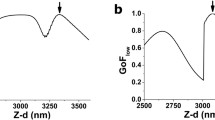Abstract
Mechanical properties are obtainable from atomic force microscopy (AFM) indentation force–depth curves, which are calculated from relationships between tip deflection and cantilever position, i.e. deflection curves. Indentation depth is the difference between tip deflections on a rigid and a soft material for the same amount of cantilever advancement, after contact is made. Since the contact point cannot be unequivocally identified from experimental data, there is some uncertainty in estimating material properties. Using simulations, this study examines some important issues related to the influence of contact point identification on estimated material properties. Simulations for linear materials using a typical stiffness for an AFM cantilever demonstrate that certain portions of the post-contact region of deflection curves for soft and very stiff materials can be approximated by quadratic and linear functions, respectively. Based on these findings, we first develop and verify an objective, automatic method to identify the contact point for materials with linear properties. We then assess the effect of misidentifying the contact point, with and without noise. If the contact point is missed by <50 nm, material properties for small indentations are erroneous but the error decreases asymptotically beyond 200 nm of indentation and the correct estimate of material stiffness is obtained. If the contact point is missed by >100 nm, however, the true material properties cannot be estimated accurately. Noise adds to uncertainty in material properties at small indentations but the combined effect of missing the contact point and noise is dominated by the former. Even though the algorithm was developed for linear materials, it is also suitable for certain nonlinear materials making it more generally applicable.
Similar content being viewed by others
References
A-Hassan E, Heinz WF, Antonik MD, D’Costa NP, Nageswaran S, Schoenenberger CA, Hoh JH (1998) Relative microelastic mapping of living cells by atomic force microscopy. Biophys J 74:1564–1578
Bowen WR, Lovitt RW, Wright CJ (2000) Application of atomic force microscopy to the study of micromechanical properties of biological materials. Biotechnol Letts 22:893–903
Briscoe BJ, Sebatian KS, Adams KS (1994) The effect of indenter geometry on the elastic response to indentation. J Phys D: Appl Phys 27:1156–1162
Burnham NA, Colton RJ (1989) Measuring the nanomechanical properties and surface forces of materials using an atomic force microscope. J Vac Sci Technol 7:2906–2913
Cleveland JP, Manne S, Bocek D, Hansma PK (1993) A nondestructive method for determining the spring constant of cantilevers for scanning force microscopy. Rev Sci Instrum 64:403–405
Costa K, Yin FCP (1999) Analysis of indentation: implication for measuring mechanical properties with atomic force microscopy. Trans ASME J Biomech Eng 121:462–471
Costa KD, Sim AJ, Yin FCP (2006) Non-Hertzian approach to analyzing mechanical properties of endothelial cells probed by atomic force microscopy. ASME J Biomech Eng 128: 176–184
Cumpson PJ, Hedley J, Zhdan P (2003) Accurate force measurement in the atomic force microscope: a microfabricated array of reference springs for easy cantilever calibration. Nanotechnology 14:918–924
D’Costa NP, Hoh JH (2005) Calibration of optical lever sensitivity for atomic force microscopy. Rev Sci Instrum 66:5096–5097
Dimitriadis EK,Horkay F, Maresca J, Kachar B, Chadwick RS (2002) Determination of elastic moduli of thin layers of soft material using the atomic force microscope. Biophys J 82:2798–2810
Gibson CT, Weeks BL, Abell C, Rayment T, Myrha S (2003) Calibration of AFM cantilever spring constants. Ultramicroscopy 97:113–118
Heinz WF Hoh JH (1998) Measuring the nanomechanical properties and surface forces of materials using an atomic force microscope. Biophys J 76:528–538
Heinz WF, Hoh JH (1999) Spatially resolved force spectroscopy of biological surfaces using the atomic force microscope. Nanotechnology 17:143–150
Hofmann UG, Rotsch C, Parak WJ, Radmacher M (1997) Investigating the cytoskeleton of chicken cardiocytes with the atomic force microscope. J Struc Biol 119:84–91
Hutter JL Bechhoefer J (1993) Calibration of atomic-force microscope tips. Rev Sci Instrum 64:1868–1873
Jaffar MJ (1995) Stresses and deformations in elastic layers indented by a conical punch. J Mech Eng Sci 209: 201–205
Jensen F (1993) Z calibration of the atomic force microscope by means of a pyramidal tip. Rev Sci Instrum 64:2595–2597
Karduna AR, Halperin HR, Yin FCP (1997) Experimental and numerical analyses of indentation in finite-sized isotropic and anisotropic rubber-like materials. Ann Biomed Eng 25:1009–1016
Lal R, John SA (1994) Biological applications of atomic force microscopy. Am J Physiol 266:C1-C21
Mathur AB, Collinsworth AM, Reichert WM, Kraus WE, Truskey GA (2001) Endothelial, cardiac muscle and skeletal muscle exhibit different viscous and elastic properties as determined by atomic force microscopy. J Biomech 34:1545–1553
Radmacher M (1997) Measuring the elastic properties of biological samples with the AFM. IEEE Eng Med Biol 16:47–57
Rotsch C, Jacobson K, Radmacher M (1999) The dynamics of active and stable edges in motile fibroblasts investigated by atomic force microscopy. Proc Natl Acad Sci USA 96:921–926
Sader JE, Larson I, Mulvaney P, White LR (1995) Method for the calibration of atomic force microscope cantilevers. Rev Sci Instrum 66:3789–3798
Sato M, Nagayama K, Kataoka N, Sasaki M, Hane K (2000) Local mechanical properties measured by atomic force microscopy for cultured bovine endothelial cells exposed to shear stress. J Biomech 33:127–135
Scholl D, Everson MP, Jaklevic RC (1994) In situ force calibration of high force constant atomic force microscope cantilevers. Rev Sci Instrum 65:2255–2257
Shroff SG, Saner DR, Lal R (1995) Dynamic micromechanical properties of cultured rat atrial myocytes measured by atomic force microscopy. Am J Physiol 269:C286-C292
Smith ST, Howard LP (1994) A precision, low-force balance and its application to atomic force microscope probe calibration. Rev Sci Instrum 65:903–909
Tao NJ, Lindsay SM, Lees S (1992) Measuring the microelastic properties of biological material. Biophys Jo 63:1165–1169
Wu HW, Kuhn T, Moy VT (1998) Mechanical properties of L929 cells measured by atomic force microscopy: Effects of anticytoskeletal drugs and membrane crosslinking. Scanning 20:389–397
Author information
Authors and Affiliations
Corresponding author
Rights and permissions
About this article
Cite this article
Crick, S.L., Yin, F.CP. Assessing Micromechanical Properties of Cells with Atomic Force Microscopy: Importance of the Contact Point. Biomech Model Mechanobiol 6, 199–210 (2007). https://doi.org/10.1007/s10237-006-0046-x
Received:
Accepted:
Published:
Issue Date:
DOI: https://doi.org/10.1007/s10237-006-0046-x




